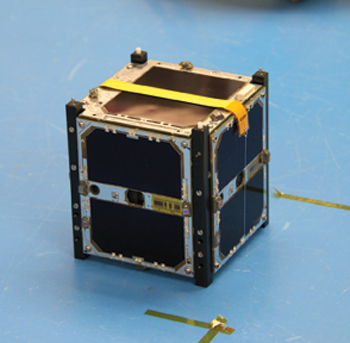Two CubeSat Technology Demonstrations Launch in December
Two CubeSat Technology Demonstrations Launch in December
– Andrea Martin, December 2013
![]()
Two Earth Science Technology Office (ESTO) funded projects launched from Vandenberg Air Force Base the evening of December 5, 2013 as part of NASA’s CubeSat Launch Initiative on the National Reconnaissance Office Launch-39 Atlas V.
The two CubeSat’s, small satellites that most typically launch as a secondary payload of larger missions, are both validation experiments to test new technologies in the space environment.
The Michigan Multipurpose Minisatellite-2 (M3, pronounced MCubed-2), built by students at the University of Michigan, carries the NASA Jet Propulsion Laboratory-developed CubeSat On-Board Processing Validation Experiment, or COVE. COVE will validate the Multiangle Spectropolarimeric Imager (MSPI) polarimetry processing algorithm using a new radiation-hard-by-design FPGA. This technology validation mission will advance the technology readiness level (TRL) for a spaceborne MSPI instrument targeted for the ACE (Aerosol-Cloud-Ecosystems) mission concept. MSPI is a very high data rate instrument designed to make measurements for cloud and aerosol science that will require on-board processing to reduce the data downlink requirements by two orders of magnitude.
The Intelligent Payload Experiment (IPEX), built by Cal Poly San Luis Obispo and JPL, will validate key aspects of the Intelligent Payload Module (IPM) technology – as well as advance its TRL – that could be used for the future HyspIRI (Hyperspectral Infrared Imager) mission concept. The IPM enables near real-time autonomous product selection and generation providing a 20x reduction in data volume for high data rate thermal infrared imaging and visible to near-infrared spectroscopy instruments, instruments used to study topics like climate, ecosystems, fire, geological resources, and coastal ocean science.
Both of the one-unit (10 centimeter cubes) CubeSats are healthy and beaconing telemetry.
The M3 and IPEX launches mark an important step in the technology development process. Validating new technologies in realistic environments ensures that should these technologies be infused into future Earth observing missions or other uses, they will be ready to accurately perform the objectives they were created to achieve.
—
For more information on emerging technologies for Earth science, visit the NASA Earth Science Technology Office website.

The MCubed-2 CubeSat, built by built by the University of Michigan’s Student Space Systems Fabrication Lab
(Credit: D. Smith, U. Michigan)

The IPEX CubeSat
(Credit: J. Bellardo, Cal Poly)